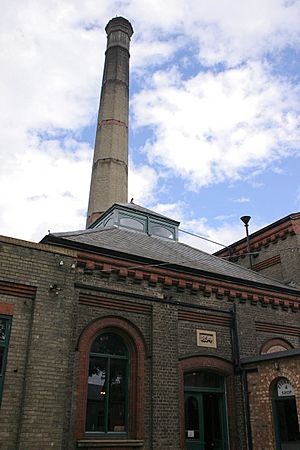Cambridge Museum of Technology facts for kids

The pumping station steam engine house
|
|
| Established | 1970 |
|---|---|
| Location | Cheddars Lane, Cambridge |
The Cambridge Museum of Technology is a cool museum in Cambridge, England. It shows off the city's amazing industrial past. The main building used to be a special station built in 1894. It pumped sewage and burned waste. This building is now a protected historical site.
The museum helps people learn about local industries and the clever people who worked in them. It's a big place next to the River Cam. There are green areas for picnics and a relaxed feel for families. You can find videos, hands-on exhibits, and activities just for kids. There are also old machines and historic buildings to explore. The Victorian Pumping Station has its original machines. They show how engineering worked in the 1800s. The museum also shares stories of forgotten Cambridge industries. These show a different side of the city, not just its famous colleges. The story continues into the 1900s. New exhibits in the Pye building feature local companies like Pye and Cambridge Scientific Instrument Company.
Contents
History of the Pumping Station
The Cheddars Lane Pumping Station first opened in 1894. It was part of a bigger plan. This plan also created a sewage farm in Milton, about two miles away. The station burned household rubbish to make steam. This steam powered engines that pumped sewage to the Milton farm. At the farm, the sewage was used as fertilizer. It helped grow crops that fed horses. These horses pulled carts that collected rubbish. The rubbish was then brought to the pumping station. Even the ash from the burned rubbish could be used to build roads.
Original Equipment from 1894
At first, the boilers that made steam for the sewage pumps were heated by burning city waste. This happened in special furnaces called destructors. These destructors are some of the only complete ones left from that time. They show a typical design for a medium-sized city waste burner.
The museum's main attractions are two Hathorn Davey steam engines. One of them still works! It often runs on special steam weekends. These engines were built to lift dirty water, like sewage and rainwater. They moved it from a pit below them to the sewage farm in Milton. The engines lifted the water about 43 feet high. They were designed to pump 250,000 gallons of sewage every hour. They did this job until 1968. After that, a new electric engine house was built nearby. However, this new site closed down in 1994.
The chimney at the station is 175 feet tall. It has eight sides and a square base. Inside, it's lined with special fire-bricks for 50 feet. The top opening is 6 feet 6 inches wide. In 1992, a famous steeplejack named Fred Dibnah climbed the chimney. He did painting and repair work. This was shown in a BBC television program.
The building now used as the print shop was built around 1900. It was a public health disinfector. Waste steam from the station was used to clean bed linen and clothes. These came from city hospitals and homes for older people. Later, it became a workshop for the pumping station.
Gas Engines Added in 1909
Cambridge was growing, and more water needed pumping after heavy rain. So, in 1909, two 94-horsepower National gas engines were added. These engines used a flat belt to power two 15-inch Rees Returbo pumps. These pumps were later replaced in 1935 by Gwynnes Limited pumps. They could pump water to Milton or to large temporary storage tanks. These tanks could hold over a million gallons of water. However, the steam engines remained the main way to pump sewage. Today, one of these gas engines is still working.
New Boiler from 1923
By the 1920s, the waste being burned had less energy. Also, rubbish was no longer collected on Sundays. This meant there wasn't always enough waste for the destructor furnaces. So, in 1923, a new Babcock & Wilcox boiler was installed. It was used when there wasn't enough waste. This boiler burned coke. Coke is a leftover product from making Coal gas. It often came from the Cambridge gas works next to the pumping station. By 1942, this new boiler provided most of the steam. The destructor cells were then only used for business waste and as a backup.
Electric Pump from 1937
The last pump installed at the site was an electric one in 1937. A Crompton Parkinson electric motor powered an 18-inch (0.45 meter) wide Gwynnes pump. This 114-horsepower electric motor can be seen at the river end of its room. Its job was to handle the increasing amounts of storm water from new housing areas.
Other Collections to See
The museum has many other cool things to see. There's a working steam winch. It pulls a small railway with wagons that tip to help remove ash. You can also see various other engines, both steam and non-steam. There's a print room with a big collection of old printing machines. This includes a Linotype machine. The museum also has a large collection of old electrical devices and much more.
See also



